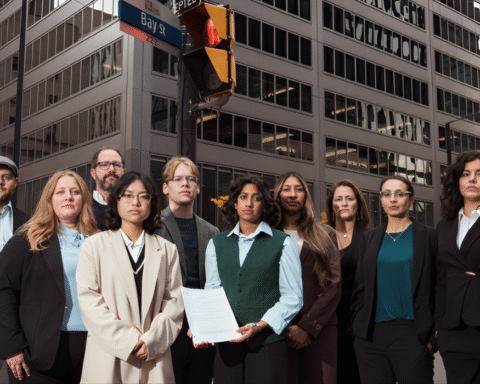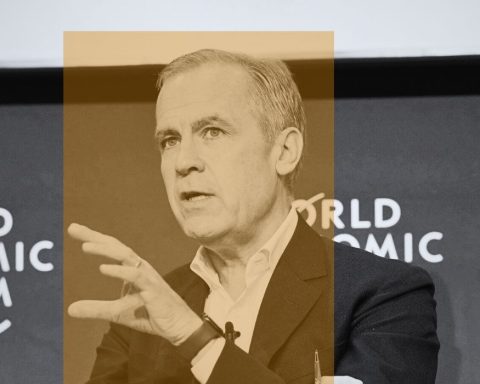As heat, storms and flooding rack the planet, the investment industry has been poked and prodded in the last decade into reallocating at least a portion of its assets to meet the opportunities and risks of the climate emergency. But recent events and trends are causing the financial centres of London, New York and Toronto to rethink support for climate finance.
Energy security has become an overriding concern in the last two years as oil and gas prices have shot up, and sustainable finance has faced an increasingly hostile political environment in the United States. A consequence of this pushback came on New Year’s Eve, when global financial behemoths Bank of America and Citigroup left the Net-Zero Banking Alliance, one of the investment industry climate coalitions championed by the United Nations.
What does this mean for the year ahead? Will financial allocators support the energy transition of the future or capitulate to the demands of the present? Here are seven predictions for the world of sustainable finance in 2025, and its related tool kit of environmental, social and governance (ESG) investing.
In the United States, sustainable investors will face attacks on three fronts
Paul Atkins, Donald Trump’s choice to chair the Securities and Exchange Commission (SEC), is an ESG skeptic with a bent to streamlining securities regulation. While not considered a hard-right ideologue, he will reverse ESG-friendly regulations championed by the Biden SEC.
1. Shareholder rights. One of Atkins’s first targets will be Biden-era SEC guidance that makes it easier for investor activists to present shareholder proposals on environmental and social issues at corporate annual meetings. Expect Atkins to reverse the Biden policies and return to guidelines under Trump’s first administration that allow companies to reject ESG proposals if they don’t substantially affect operations.
Expect the Republican-controlled Congress to also weigh in, proposing legislation that would give corporations broad powers to reject shareholder proposals. That said, it’s not clear whether such a law could pass in the next two years, when the 2026 mid-term elections are expected to turn against the Republicans.
2. Climate disclosure. Atkins will also revoke a Biden-SEC regulation requiring publicly listed companies in the United States to disclose their Scope 1 and 2 (operational and energy) carbon dioxide emissions. The impact of this reversal will be muted, however, as climate disclosure rules take effect in California and in Europe, where about 3,000 U.S. companies operating in Europe will have to comply with climate disclosure rules under its Corporate Sustainability Reporting Directive (CSRD).
3. ESG fiduciary rights. And expect the Trump administration to reverse a Biden Department of Labor rule expressly permitting pension trustees to consider ESG issues in investment decisions. But the Trump rule will be contested in the courts, as sustainably invested pension funds make a legal case that ESG is fundamentally about improving financial assessment of financial risks and returns.
The takeaway: The Trump administration’s attack on shareholder rights will discourage investors from exercising their rights to file investor proposals on ESG issues. But on climate disclosure and fiduciary rights, this will create regulatory confusion more than a firm barrier to sustainable investing.
Shareholder proposals on ESG issues will drop in number and support
Shareholder collaboration on ESG issues will take a hit in 2025. Collaborations like the Climate Action 100+ shareholder network will lose clout, as policy changes and the chill from the Trump administration take hold. In 2024, large U.S. asset manager Franklin Templeton joined other managers Nuveen, Goldman Sachs Asset Management and AllianceBernstein in leaving the network, which coordinates shareholder pressure on corporations on climate issues.
According to Morningstar data, the number of ESG resolutions at U.S. companies rose sharply between 2021 and 2024, although overall support was 27% in 2024, down from 37% in 2021. The decline was largely due to lower levels of support from the three largest asset managers: BlackRock, Vanguard and State Street, together known as the Big Three. There has been some pushback from at least one asset owner – PGGM – which has dropped some managers that are not meeting the Dutch pension fund’s expectations for ESG engagement.
The takeaway: In 2025, look for fewer but better-focused ESG proposals that can command larger support from asset owners and managers.
Long-term ESG-focused investors will stay the course
Despite these negative trends, 50% of long-term ESG-oriented investors – including asset managers, funds and owners employing sustainable finance strategies – said they plan to maintain their current level of ESG activity in 2025, while 29% said they plan to increase it moderately and 10% plan a significant expansion, according to a survey by the U.S. Sustainable Investment Forum (US SIF).
Many Republican-led states are dropping companies with ESG policies as eligible managers for their pensions funds. But large managers like the Big Three have substantial accounts with Democratic-led states and European clients that are under their own stakeholder and regulatory pressure to meet climate and ESG targets. US SIF reported that sustainable assets under management at the end of 2023 were US$6.5 trillion, representing 12% of total investment assets in the United States.
The takeaway: ESG strategies have become embedded in a large proportion of the long-term asset-owner and -management sectors. Expect continued growth of sustainable finance assets by these investors in 2025, especially by pension funds weighing the evolving risks of heat, floods and storms and economic transformations from climate change.
Related
Sustainable investors are split on just how bad Trump will be for the green economy
Death of ESG is greatly exaggerated, say pension managers
Why this investor advocate quit filing oil and gas shareholder proposals
Shorter-term mutual fund and ETF investors will cautiously re-enter the sustainable funds market
Unlike core ESG investors committed to long-term sustainable strategies, interest by small institutions and individuals with shorter investment horizons has waned in recent years. Inflows in sustainable mutual funds and exchange traded funds (ETFs), two products popular with these investors, hit US$160 billion in the fourth quarter of 2021, triggered by low interest rates and climate-friendly policies in the European Union. But these dropped precipitously starting in 2022, when central banks ramped up interest rates, the Ukraine war drove up energy prices, and Europe established more stringent anti-greenwash fund-disclosure rules.
By the second quarter of 2024, Morningstar estimates that net inflows had dropped to US$6.3 billion, with the United States registering net outflows. Not surprisingly, Morningstar estimates there were 246 new sustainable funds launched in the first three quarters of 2024, down from 444 in the same period in 2023.
But there are early signs this outflow is beginning to turn around. Global flows into sustainable mutual funds and ETFs hit US$10.4 billion in net new money in the third quarter of 2024, driven largely by reduced outflows from the United States. It appears investors are gaining comfort with the new European rules and longer-term prospects for green stocks, although there was a sell-off of clean energy immediately after the U.S. election.
The takeaway: Expect sustainable mutual fund and ETF inflows to bottom out in 2025 and investors to return to these products, as long-term interest rates improve conditions for green bonds and climate-friendly stocks and European investors become more familiar with ESG fund-disclosure rules.
Europe will simplify, not throw out, ESG disclosure rules
European Commission President Ursula von der Leyen has proposed an “omnibus” reform of corporate and finance disclosure rules aimed at simplifying the complex web of ESG reporting requirements imposed by the European Union. “The questions we are asking, the data points we are collecting – thousands of them – is too much,” she said at a meeting of EU heads of state last year.
The political balance at the European Parliament shifted to conservative parties in 2024 elections, sparking a fear of wholesale disclosure deregulation. But with thousands of companies investing in resources to meet the stringent rules this year, the European Commission would invite significant blowback and market confusion if it threw out the reporting regime.
The takeaway: Look for the European Commission to overhaul the information requirements in 2025, in a spirit of getting to the core of sustainability outcomes, not tossing out the whole framework in a U.S.-style attack on ESG.
Canada will become a leader on transition investing
Canada is expected to appoint an arm’s-length council in 2025 to oversee a new green and transition taxonomy, an official standard for banks, funds and asset managers on green and transition investments.
One of the big questions is whether gas projects like liquefied natural gas infrastructure will qualify for the “transition” label. Guidelines set by the federal government in 2024 rule out new gas production for the transition label. Existing natural gas production displacing coal could be transition-eligible but would have to be aligned with a global temperature rise of no more than 1.5°C. These are important marching orders for the arm’s-length council, which will likely follow the federal mandate to rule out projects with significant carbon lock-in.
The takeaway: The taxonomy will help Canada to become a leader in transition projects in areas such as green steel and cement and the gradual phaseout of fossil fuel power with clean energy. That is, if the taxonomy is even finalized under the precarious situation facing the current government.
Canada will impose mandatory full-scope carbon emission reporting – but it won’t come in 2025
In December, the Canadian Sustainability Standards Board (CSSB) adopted international accounting rules calling on Canadian corporations to report the full range of their carbon emissions. That is, not only Scopes 1 and 2 emissions from operations and energy, but also Scope 3 emissions from end uses.
However, the rules include a two-year delay for Scope 1 and 2 reporting and a further year for Scope 3 reporting. It’s now up to the Canadian Securities Administrators, the umbrella organization for securities commissions, to decide whether to follow through on the CSSB recommendation and make full carbon-emission disclosure mandatory.
The takeaway: Alberta will almost surely fight full disclosure, since the oil and gas industry is responsible for about 30% of Canada’s total emissions, particularly on Scope 3. But I’m going to go out on a limb here and predict that the other provinces will win this battle, backing the CSSB’s carefully crafted consensus to bring Canada into alignment with Europe and many other jurisdictions in 2027 and 2028.
The big picture
Stronger-than-expected anti-ESG attacks in the United States or Europe could put a very cold chill on green investing in 2025, but right now it looks like sustainable investing has built sufficient strength in the last decade to withstand the growing conservative backlash against it.
Eugene Ellmen writes on sustainable business and finance. He is a former executive director of the Canadian Social Investment Organization (now the Responsible Investment Association).







